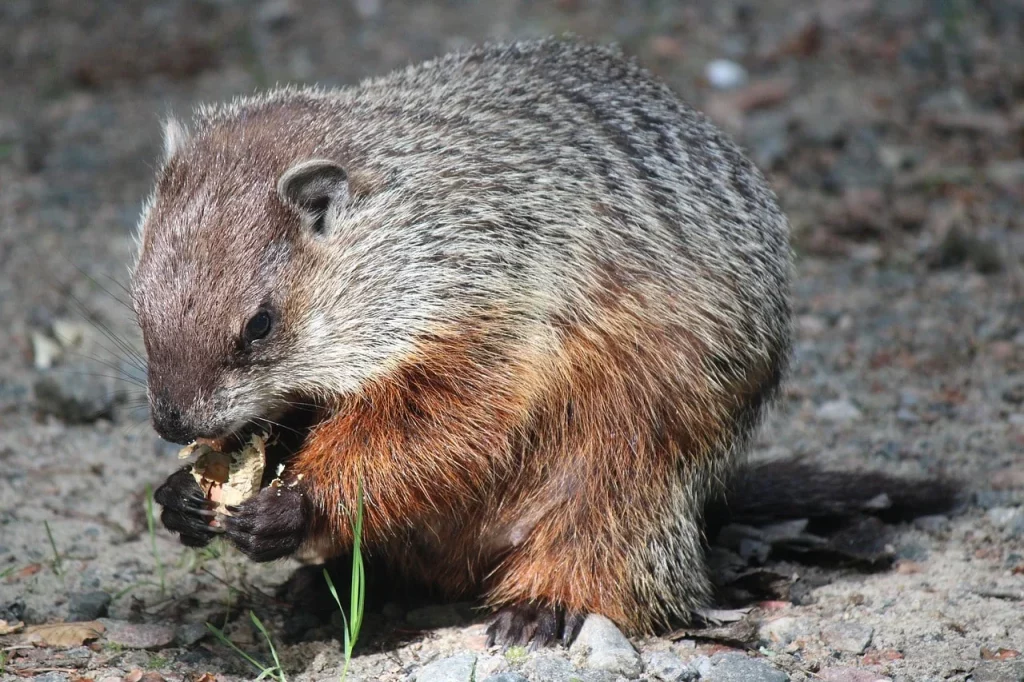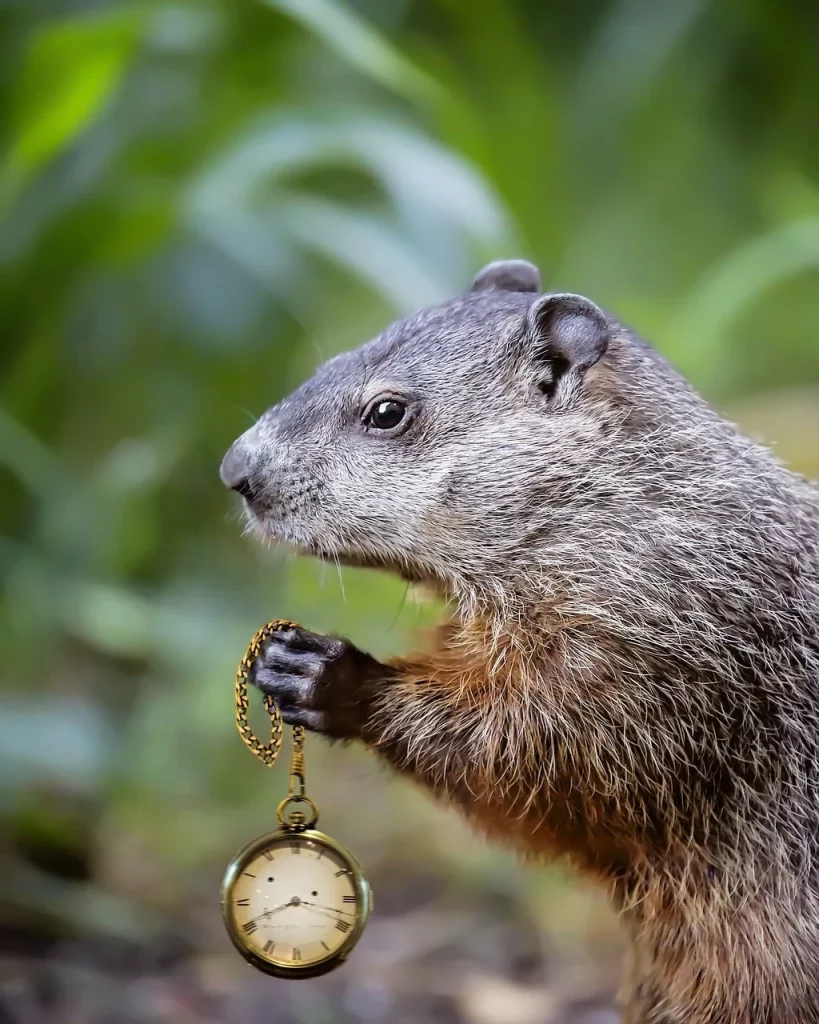Welcome to the world of groundhogs, where these furry forecasters are more than just a shadow-spotting spectacle every February 2nd. Groundhogs, also known as woodchucks (which, despite the name, do not chuck wood), are fascinating creatures with a myriad of quirks and qualities.
Did you know that groundhogs are the only animals with their own U.S. holiday? That’s right, not even eagles can boast that! In this delightful dive into some interesting groundhog facts, we’ll explore everything from their weather-predicting prowess to their surprisingly social lives. So, are you ready to become a groundhog guru?
The groundhog is like most other prophets; it delivers its prediction and then disappears.
Bill Vaughan
Groundhog Facts
Before you dive into the fascinating world of groundhogs, remember: a fun quiz awaits at the end of this article. Read carefully to become a true groundhog expert.
- The woodchuck, commonly referred to as the groundhog, is part of the marmot family, a group of large ground squirrels.
- Originating from North America, they predominantly inhabit the United States and Canada.
- Groundhogs are known for their hibernation habits, entering a state of deep sleep from autumn until the spring.
- During their hibernation period, a groundhog’s body temperature can decrease to around 5 degrees Celsius (41 degrees Fahrenheit).
- These animals predominantly feed on plants, including a variety of fruits, vegetables, and grasses.
- Notable for their digging abilities, groundhogs create extensive underground burrows with several entry points.
- Groundhogs communicate through a range of sounds, movements, and scent marks.
- Equipped with powerful teeth and claws, they use these for both excavation and defense.
- Capable of climbing and swimming, groundhogs use these skills for foraging and evasion.
- In the wild, groundhogs typically have a lifespan of around 6 years, which can extend in captivity.
- Often seen as nuisances by farmers, groundhogs can damage crops and gardens with their burrowing and feeding.
- The gestation period for groundhogs is about 32 days, leading to the birth of 2 to 6 young.
- Newborn groundhogs, or kits/pups, are initially blind and without fur.

- Known for a distinctive whistling sound, groundhogs are sometimes called whistle-pigs.
- They rely heavily on their acute hearing and strong sense of smell for survival.
- Groundhog Day, celebrated on February 2nd, revolves around the legend that if a groundhog sees its shadow, winter will last six more weeks.
- The weather predictions of Groundhog Day hold no scientific validity.
- Typically solitary, groundhogs come together only for mating.
- They can inflict considerable damage to agricultural areas due to their diet.
- Groundhogs possess constantly growing incisors, essential for their digging lifestyle.
- They play an ecological role in soil aeration and water infiltration through their burrowing habits.
- Hawks, foxes, and coyotes are among the predators of groundhogs.
- Groundhogs sometimes engage in sunning themselves at their burrow entrances, a behavior known as basking.
- With a stout body, short limbs, and a bushy tail, groundhogs are built for efficient digging.
- An adult groundhog weighs typically between 5 to 12 pounds (2-5.5 kg).
- Their fur is generally grayish-brown, which offers camouflage from predators.
- Groundhogs are skilled diggers, often constructing burrows with multiple exits for safety.
- These animals have limited eyesight, depending more on their sense of smell and hearing.

- Other animals, like rabbits and skunks, sometimes share groundhog burrows.
- Early mornings and late afternoons are the primary active periods for these creatures.
- Despite their reputation in folklore, groundhogs are not accurate weather forecasters.
- They eat heavily in the summer and autumn to accumulate fat for their hibernation period.
- A groundhog’s incisors can grow at a rate of about 1/16th inch weekly.
- Throughout hibernation, groundhogs survive on the fat reserves they built up previously.
- The alternative name ‘Woodchuck’ originates from the Algonquian word wuchak.
- Groundhogs are sometimes used in biomedical research due to their hibernation patterns resembling human sleep disorders.
- They can ascend small trees and structures to look out for threats or find food.
- A groundhog’s territory can span 2 to 3 acres.

- Groundhogs have the unique ability to recycle their bodily waste during the hibernation period.
- During mating season, these animals become territorial and may show aggression towards others of their kind.
- By late summer, young groundhogs are usually ready to leave their mother’s nest.
- Their paw prints are distinctive, with five toes on the hind feet and four on the front, including visible claw marks.
- Groundhogs are often the subject of mythology and cultural stories in North America.
- Some Native American cultures regard the groundhog as a symbol of fortune and prosperity.
- Groundhogs produce a range of sounds, including barks, screams, and grunts for communication.
- They are known to gnaw on various materials, potentially causing damage to structures.
- Groundhog burrows typically have a dedicated chamber used as a latrine, separate from their sleeping area.
- Being diurnal, they are active during the day and rest at night.
- The population status of groundhogs is not considered endangered or threatened.
- Through their digging, groundhogs can inadvertently improve soil quality and enhance fertility.
Groundhog Myths

Now that we’ve explored all these fun facts about groundhogs, let’s dive into the myths. It’s time to separate fact from fiction and discover the actual truth.
- Groundhogs Can Predict the Weather
The belief that groundhogs can predict the coming of spring is a charming tradition, but scientifically, their shadows do not influence weather patterns. Meteorological predictions are made using sophisticated equipment, and a groundhog’s reaction to its shadow is not linked to weather forecasting. - Groundhogs Are Aggressive Animals
Generally, they are shy and prefer to avoid humans. When confronted, they may hiss or growl as a defense mechanism, but aggression is not commonly observed. These creatures are more inclined to retreat to their burrows than to confront a perceived threat. - Groundhogs Hibernate Throughout the Entire Winter
It is widely believed that they hibernate deeply all winter. In reality, they enter a state of torpor, which is a lighter form of hibernation. During this period, they can wake up and move around inside their burrows, although they generally stay underground until spring. - Groundhogs Are Solitary Creatures
While groundhogs are not highly social animals, they are not strictly solitary. During the breeding season, they interact more frequently, and mothers show a high level of care for their young. Outside of breeding, they prefer a more solitary lifestyle but can coexist in close proximity to others. - Groundhogs Only Eat Garden Plants
They are often blamed for damaging gardens, but their diet is diverse. They primarily eat wild grasses, fruits, and vegetables. In addition to garden plants, they consume insects and other small animals, making their diet more varied than commonly assumed.
No products found.
Groundhog Quotes

I had a hard time searching for quotes about groundhogs, but I managed to find a nice list. Below are my favorite ones. If you have some, you can also write them in the comments so I can add them to the list as well.
To shorten winter, borrow some money due in spring.
W.J. Vogel
W.J. Vogel humorously suggests that anticipating a debt repayment can make winter seem shorter, much like the groundhog’s prediction.
Groundhog Day is a lot like a rock concert but the people are better behaved and there’s a groundhog involved.
Tom Chapin
Tom Chapin humorously compares the excitement and behavior of people at Groundhog Day celebrations to that of a rock concert audience.
The trouble with weather forecasting is that it’s right too often for us to ignore it and wrong too often for us to rely on it.
Patrick Young
Patrick Young’s quote playfully critiques weather forecasting, paralleling the groundhog’s own hit-or-miss predictions.
Don’t knock the weather; nine-tenths of the people couldn’t start a conversation if it didn’t change once in a while.
Kin Hubbard
Kin Hubbard humorously points out how weather, much like the groundhog’s prediction, serves as a universal conversation starter.
I’m a little groundhog, furry and brown, I pop up my head and I look around.
Traditional Groundhog Day Song
This line from a traditional Groundhog Day song personifies the groundhog, capturing its curious and cautious nature.
Groundhog FAQ

As we move forward in our journey, we come across the FAQ section. Read these answers carefully because they are going to help you in the upcoming quiz.
- Will groundhogs attack dogs?
They generally avoid confrontations. They are shy creatures and prefer to retreat when they sense danger. However, if a dog provokes or corners a groundhog, it might defend itself. Groundhogs have sharp teeth and claws, so it’s best to keep pets away from them to prevent any possible harm. - Why is Groundhog Day celebrated?
Groundhog Day, celebrated on February 2nd, is a popular tradition in the United States and Canada. The folklore states that if a groundhog emerging from its burrow sees its shadow due to clear weather, it will retreat back into its burrow, indicating six more weeks of winter. If it doesn’t see its shadow because of cloudiness, spring will arrive early. This tradition has its roots in German communities and has been observed since the 18th century. - Can groundhogs climb trees?
Surprisingly, yes! Groundhogs, primarily known for their burrowing habits, are also capable climbers. They climb trees to escape predators or to eat from fruit trees. However, they spend most of their time on or under the ground and are not frequently seen climbing. - Are groundhogs dangerous?
They are not typically dangerous to humans. They are mostly herbivorous and shy away from human interaction. However, like any wild animal, they can become aggressive if they feel threatened or cornered. It’s important to maintain a respectful distance from them in their natural habitat. - Can groundhogs get rabies?
Yes, they can contract rabies. They are among the few rodent species that are susceptible to the virus. Rabid groundhogs may show unusual behavior, such as aggression or lethargy. It’s crucial to avoid any wild animal that appears sick and to contact animal control professionals if you suspect rabies.
No products found.
Groundhog Trivia

Welcome to our groundhog quiz! If you don’t get any questions right, be prepared to wake up tomorrow with a sudden urge to predict the weather!
Conclusion
As we wrap up our journey through the world of groundhogs, it’s clear these creatures are more than just weather predictors. Their role in ecosystems as burrowers and foragers is vital, often shaping the landscapes they inhabit.
But beyond their ecological impact, groundhogs have captured our hearts and imaginations, becoming cultural icons in their own right. Isn’t it fascinating how a small animal can influence both the environment and popular culture so significantly?
So next time you spot a groundhog, remember, there’s much more to these furry forecasters than meets the eye. And for our funny question: If you were a groundhog, what kind of weather would you predict for tomorrow? Let me know in the comments.
3 Sources Used For This ArticleRiver Otter Dangerous – Animal Queries
Groundhogs as Weather Forecasters – Anim Answers


